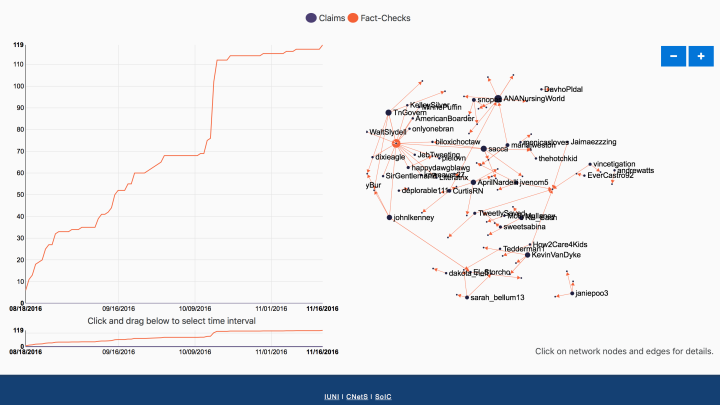
A quick search of a keyword on Hoaxy turns up several different stories on the topic along with the number of related tweets, the source, and whether or not Snopes and similar resources have debunked the topic yet. Adding a checkmark next to a topic creates a visual graph of how that “news” spread.
Hoaxy puts shares on a graph — shares stem out in a web-like pattern from the original share, then new webs span off those secondary shares, creating a visual of just how the information spread.
Along with mapping out the spread of unverified news, the system tracks the number of fact checks by independent websites, including snopes.com, politifact.com and factcheck.org.
The beta program comes from the Observatory on Social Media at Indiana University, stemming from work by IU Network Science Institute researcher Filippo Menczer. Several years ago, Menczer first became interested in studying the spread of fake news when he launched an experimental celebrity rumor website that explicitly stated the news was false — and just a few months later received a check for the site’s advertising revenue.
“In the past year, the influence of fake news in the U.S. has grown from a niche concern to a phenomenon with the power to sway public opinion,” Menczer said. “We’ve now seen examples of fake news inspiring real-life danger, such as the gunman who fired shots in a Washington D.C. pizza parlor in response to false claims of child trafficking.”
While the beta version currently only tracks public Twitter posts, Menczer says that understanding how fake news spreads is the first step to stop the growing influence of fake news.
Hoaxy doesn’t decide what’s true and what’s false, either — but simply tracks the spread of unverified stories. “Not all claims you can visualize on Hoaxy are false, nor are we saying that the fact-checkers are accurate 100 percent of the time,” Menczer said. “Hoaxy is a tool to observe how unverified stories and the fact-checking of those stories spreads on social media. It’s up to users to evaluate the evidence about a claim and its rebuttal.”
Editors' Recommendations
- As it turns out, TikTok isn’t a reliable search engine for news
- Elon Musk holds off on Twitter deal pending fake account data review
- Fortnite gets spooky with the new Midas’ Revenge Halloween event
- Amazon’s new crime unit targets fraudsters selling fake goods
- Report: Instagram set to become a more popular news source than Twitter




